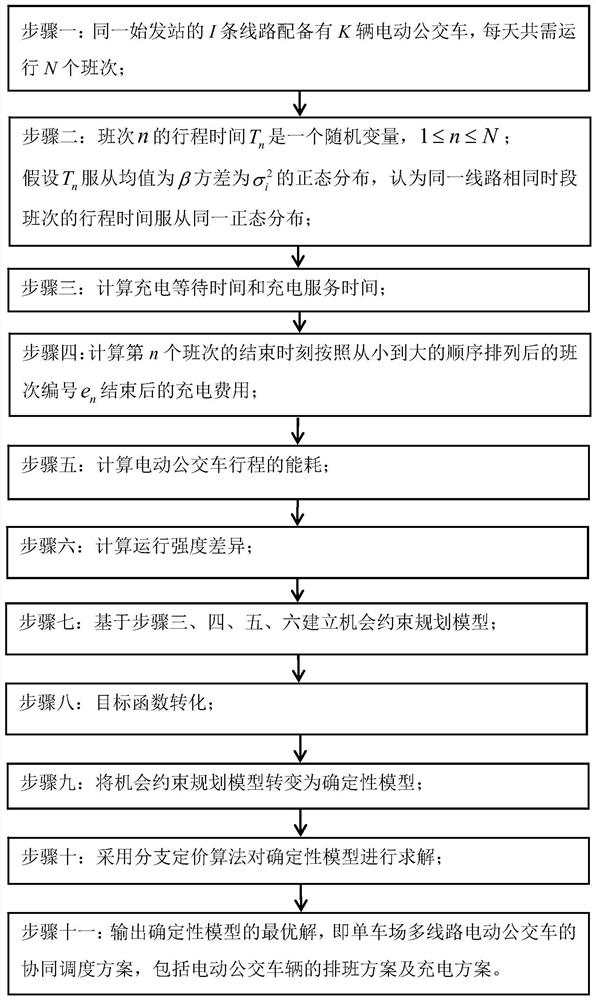Multi-line electric bus cooperative scheduling method for single-vehicle yard
An electric bus and collaborative scheduling technology, applied in data processing applications, instruments, calculations, etc., can solve the problems of different service life of electric buses, without considering the randomness of electric bus travel time and the difference in operating intensity, etc., to achieve reduction Operating costs and convenient management, the effect of promoting development
- Summary
- Abstract
- Description
- Claims
- Application Information
AI Technical Summary
Problems solved by technology
Method used
Image
Examples
specific Embodiment approach 1
[0024] Specific implementation mode 1: In this implementation mode, a method for coordinated dispatching of multi-line electric buses in a bicycle yard The specific process is as follows:
[0025] Step 1: The I line of the same departure station is equipped with K electric buses, and a total of N shifts need to be run every day, and the values of the above parameters are obtained based on the actual line;
[0026] For example: there are bus line 1, bus line 2, and bus line 3 at the same departure station, each bus line has 10 vehicles, K takes 30, and 30 vehicles run a total of N shifts every day;
[0027] Said 1 shift means that 1 electric bus returns to the departure station after departure;
[0028] Step 2: Travel time T of shift n n is a random variable, 1≤n≤N;
[0029] Suppose T n Obeying the mean is β and the variance is The normal distribution of , it is considered that the travel time of the same line and the same period of time is subject to the same normal dis...
specific Embodiment approach 2
[0040] Embodiment 2: This embodiment differs from Embodiment 1 in that the charging waiting time (Formula 8) and charging service time (Formula 12) are calculated in Step 3; the specific process is:
[0041] The set of trips served by electric bus k, C k is the number of shifts executed by electric bus k, k=1,2,...,K,C k =1,2,...,N,j=1,2,...,C k ;
[0042] E={e 1 ,e 2 ,...,e N}is the set of shift numbers arranged in ascending order of the end times of N shifts;
[0043] C={te 1 ,te 2 ,...,te N} is the time set of the end time of N shifts arranged in ascending order, that is, the set of the time when the current shift of the electric bus ends and returns to the departure station; that is, shift e n The moment when the operation ends and returns to the originating station is te n ;
[0044] S={s 1 ,s 2 ,...,s N} is the number set of the next shift executed by the electric bus that executes the shift at the same position in the set E;
[0045] if te n Last run f...
specific Embodiment approach 3
[0092] Specific implementation mode three: the difference between this implementation mode and specific implementation mode one or two is that the shift e is calculated in the step four n Charging costs after the end The specific process is:
[0093]
[0094] In the formula: for shift e n The charging time of the previous electricity price period in the case of crossing the adjacent electricity price period after the end, the unit is min; for shift e n The charging time of the next electricity price period in the case of crossing the adjacent electricity price period after the end, the unit is min; h is the number of the time-of-use electricity price period, h=1,2,...,H, there are H periods in total; Q h is the electricity price in time period h in the time-of-use electricity price, Q h+1 is the electricity price in time period h+1 in the time-of-use electricity price;
[0095]
[0096]
[0097] In the formula: is the end time of time-of-use electricity pri...
PUM
 Login to View More
Login to View More Abstract
Description
Claims
Application Information
 Login to View More
Login to View More - R&D
- Intellectual Property
- Life Sciences
- Materials
- Tech Scout
- Unparalleled Data Quality
- Higher Quality Content
- 60% Fewer Hallucinations
Browse by: Latest US Patents, China's latest patents, Technical Efficacy Thesaurus, Application Domain, Technology Topic, Popular Technical Reports.
© 2025 PatSnap. All rights reserved.Legal|Privacy policy|Modern Slavery Act Transparency Statement|Sitemap|About US| Contact US: help@patsnap.com



